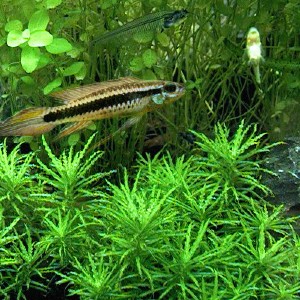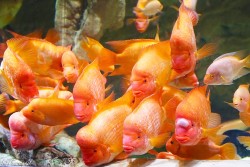Black Stripe Dwarf Cichlid (Taeniacara candidi) CareSheet
 The Taeniacara candidi, often known as the Black Stripe Dwarf Cichlid, is a South American cichlid that originated in the Amazon Basin. These fish have a black stripe running horizontally from the snout to the base of the tail, and their bodies are exceedingly thin and elongated. Its relatively low dorsal fin is another unique trait. The Black Stripe Dwarf Cichlid should be housed in a tank with densely planted clusters that is at least 20 gallons. They demand a large number of open swimming areas as well as hiding spots. It's best to use a fine gravel to sand substrate. They are semiaggressive, but also shy, and should not be kept alongside huge, aggressive fish.
The Taeniacara candidi, often known as the Black Stripe Dwarf Cichlid, is a South American cichlid that originated in the Amazon Basin. These fish have a black stripe running horizontally from the snout to the base of the tail, and their bodies are exceedingly thin and elongated. Its relatively low dorsal fin is another unique trait. The Black Stripe Dwarf Cichlid should be housed in a tank with densely planted clusters that is at least 20 gallons. They demand a large number of open swimming areas as well as hiding spots. It's best to use a fine gravel to sand substrate. They are semiaggressive, but also shy, and should not be kept alongside huge, aggressive fish.They need proper water conditions and must be changed on a regular basis. The Black Stripe Dwarf Cichlid is an egg layer that loves to deposit her eggs on the undersides of leaves or driftwood. The male will arrive after the female has deposited her eggs to fertilize them. The male then abandons the brood to the female after conception. Within seven to ten days, the fry will be able to swim on their own, at which point they should be fed freshly born brine shrimp. The fry will achieve sexual maturity in around five months since they are a fast-growing species.
The carnivorous Black Stripe Dwarf Cichlid will eat a broad range of foods. These fish will eat freeze-dried bloodworms and tubifex, flake food, and both frozen and live brine shrimp and worms.
Requirements for keeping Taeniacara candidi
Common Name: Black Stripe Dwarf Cichlid
Scientific Name: Taeniacara candidi
Species: Cichlid
Origin: Native to South America, specifically found in the Rio Orinoco basin in Venezuela.
Size: Adult Taeniacara candidi typically reach lengths of around 2 to 3 inches (5 to 8 cm).
Care Level: Moderate
Temperament: Generally peaceful, but they can display territorial behavior during breeding.
Diet: Carnivorous; they primarily feed on small invertebrates and insect larvae. In captivity, they accept high-quality pellets, live or frozen foods like brine shrimp and bloodworms.
Minimum Tank Size: A tank with a minimum capacity of 20 gallons is suitable for a small group of Taeniacara candidi.
Temperature: They thrive in a temperature range of 74°F to 80°F (23°C to 27°C).
pH Range: Prefers slightly acidic to neutral water conditions, with a pH level between 6.0 and 7.0.

Looks like we are out of stock for Taeniacara candidi.
Click Here to See More Great Items on eBay!